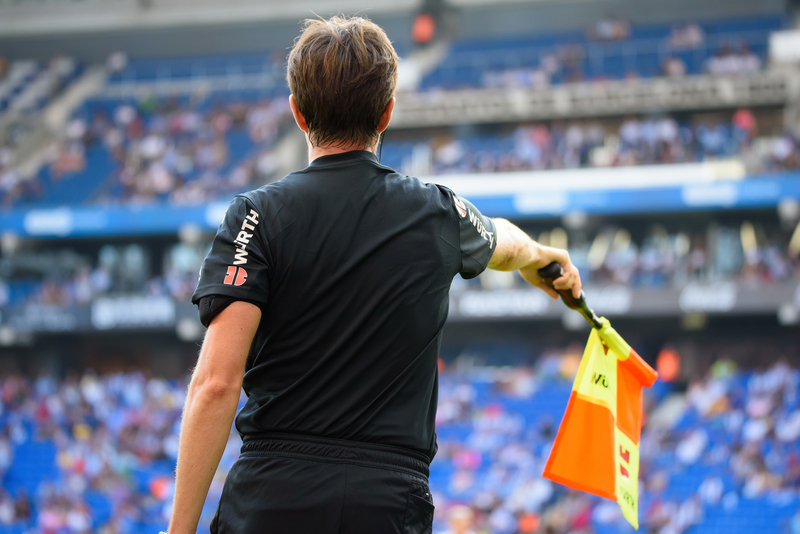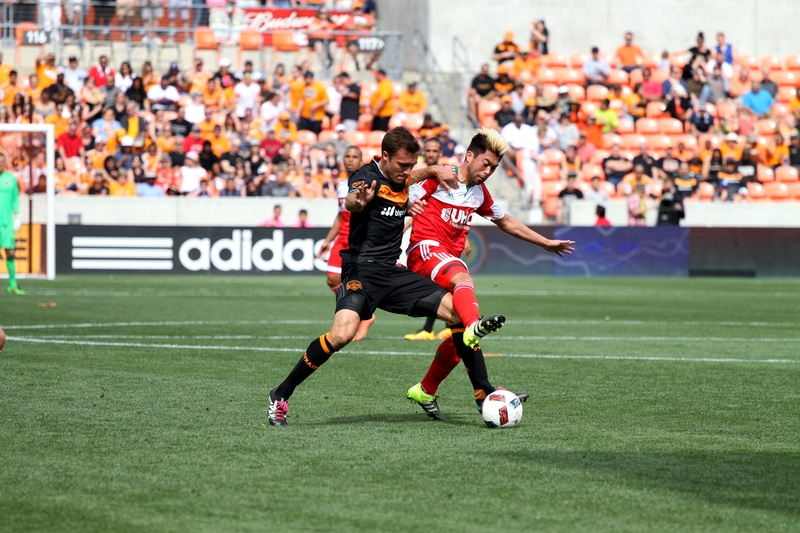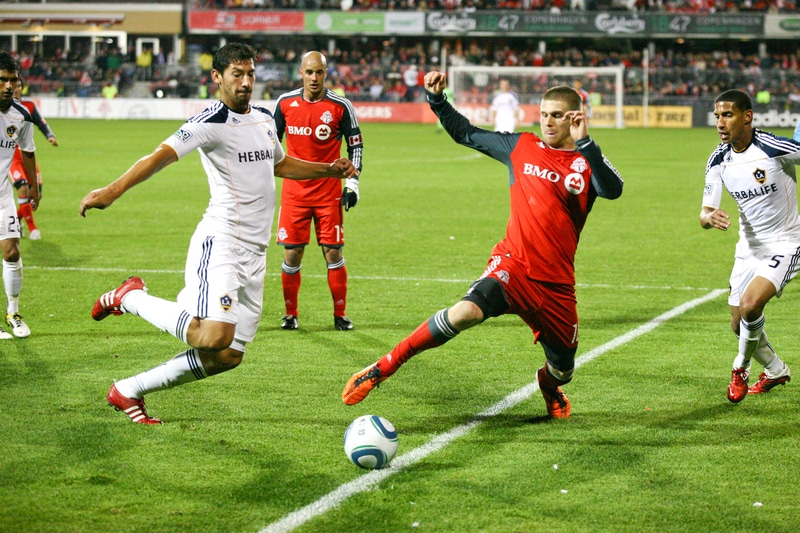Last updated on November 8th, 2023 at 10:18 am
Offsides occur in soccer occurs when an offensive player is beyond the second to last defender (last being the goalie) on the opposing team’s half on the pitch and touches the ball. In simple language, offsides prevent players from camping near the goal area and waiting for their teammates to pass the ball to them from across the pitch. When offsides occur, the referee will stop the play, and the other team will take over possession.
In soccer, an attacking player is offside if they are active in play, ahead of the ball, and the second to last defender. The play is offside when the player touches the soccer ball from their teammate. For example, if a player takes off from their defender to create space for them on the pitch to receive a pass, they will be offsides.
However, it is worth noting that players can separate from their defenders on the pitch to get the ball. They can only run past the second-to-last defender once the kick occurs to ensure it won’t be offsides. With the help of VAR (video assistant referee), game officials can see precisely if a player left too soon before the kick.
How Does the Referee Signal Offsides?
A referee (match official) signals an offsides call by raising their flag and pointing it towards the field. During a game, you will see sideline referees running with the play. When watching a game, you can use them as a visual indicator because they follow the pitch’s second-to-last defender. That means the referee will signal offsides if an offside player is beyond that second-to-last defender and touches the ball before it was passed to them.
An onside position player must stay in line with the second-to-last defender until the kick occurs. Once the kick occurs, that player can run beyond the second to last defender if the ball travels there and make contact with it. However, if they leave before the kick to create space and touch the ball, it becomes offsides.
What is the Penalty for an Offsides Player in Soccer?
If a referee calls a player on an offsides offense, there is a stoppage. The defensive team then receives an indirect free kick. This kick differs from a standard penalty kick or direct kick because it cannot be aimed directly at the goal.
Also, even if a goal occurs from offside, it won’t be a goal. Since the goal came from offsides, the referee will call off the goal.
What is an Offside Trap in Soccer?
An offside trap is a way to create an offsides penalty against the offensive playing team. For example, on a corner kick, the defense might make a line in front of their goalie. Before the kick occurs, one of the offensive players might be slightly in front of the line and between the goalie since they can’t get around the defensive line. That means if they touch the ball on the corner kick as it comes to them, it becomes offsides.
Another offsides trap that teams create is creating space between offensive players and themselves. For example, the offensive player might stay a step or two behind a defensive player in anticipation of sprinting down the field on a kick. Suppose a defender sees this play developing. In that case, they can risk running towards the opposite goal, leaving the offensive player in an offsides position since the defender is now behind the offensive player. Doing this is risky because a player might not be able to get behind the offensive player before the kick, which could turn into a breakaway for the offensive soccer player to attempt a goal.
Why is Offsides Important in Soccer?
Soccer offside penalties prevent players from cherry-picking or waiting behind the defense for a pass. When players wait for these long passes, they can cause disruptions in the game, including high-risk scoring opportunities and boring plays in the middle of the field. By enforcing an offside rule, FIFA and the IFAB push the game to pass and dribble.
Rules preventing this kind of open attack on the goal have been part of the game from the start. In these early versions of the offsides rule, players could not accept a pass if they are far out in front of the ball. However, these early rule sets often lacked firm guidelines or penalties for players who committed fouls.
When Did the Official Soccer Offsides Rule Originate?
Association football began adopting proper offsides rules in 1863 and continues adapting and building off those rules in the years since. Today, the offsides rule is official Law 11 of the Laws of the Game.
When is a Play Active in Soccer?
The Laws of the Game stipulate a few different criteria for deciding if a player is in active play.
- They are interfering with a player
- They are blocking a view of the play for another player
- Receiving a pass from another player
What Makes Active Play so Confusing in Soccer?
A player can be in an offsides position when they receive a pass. The offside law is judged only by the players’ position when an offensive player kicks the soccer ball to make a pass. If a player is not offsides before or during a kick, they can race past the defenders to receive the pass as part of a breakaway.
Why are Offsides Calls so Hard to Make in Soccer (Association Football)?
The transitional nature of the offsides call makes this penalty challenging for referees and fans alike to recognize. You have to acknowledge a player offsides when a pass is kicked and then call them once they become active in the play. Since the definition of offsides states that it’s not a penalty to stand in an offside position, officials can miss it.
The football association rules allow two assistant referees, which function like linesmen, to help officiate the game. The role of these referees is to look specifically for fouls away from the ball. These fouls include offsides, evaluating when teams are eligible for corner kicks, and indicating substitutions. You will notice these referees on the sidelines of the pitch following the second to last defender to ensure there are no offsides.
In What Situations are There No Offsides in Soccer?
Given that the offside rule prevents uneven offense and cherry-picking, there are several situations when offsides don’t happen. These situations often include players behind the ball when it’s kicked, like penalty kicks from the penalty area, throw-ins, and corner kicks.
- A player can’t be called on offsides if they’re behind the ball when it’s passed or kicked. For example, in a two-person, odd-man rush, if an attacking player passes the ball to a trailing teammate, no offsides are called (even if they’re behind the second-last opponent.)
- Similarly, there are no offsides during the first pass after a corner kick, indirect kick, or throw-in. There are no offsides call here because the game begins, but offside penalties resume after this happens. Also, there is no offsides call because most players are behind the ball when these plays start.
- Finally, offsides don’t occur when a player is on their half of the field of play. This no-offsides call allows teams to use their entire area to establish a good defense against an attack and set up a solid offensive drive.
Offsides as a Defensive Tactic
Many teams employ a defensive tactic called the offsides trap to try and force attacking players to incite a foul. This trap is risky because it requires defensive players to sprint toward the opposing team. Running upfield can leave a team’s goalkeeper defenseless, especially if the officiating crew misses the penalty or rules that offsides didn’t occur in the play.
Offside rules specify that an attacking player cannot be closer to the opponent’s goal line than the second-to-last defending player. It’s important to know that soccer rules often consider a goalie the last defending player on a team. The second-to-last defenseman is the last defender in the outfield. This specification gives defensemen power to execute the offsides trap and cause the offensive team to draw a penalty.
However, if a player on the defending team passes the ball to a player on the opposite team in an offsides position, the play is not offsides. An offsides penalty only occurs when a pass is between two teammates on the same side.
Conclusion: What is Offside in Soccer?
In summary, offsides in soccer mean you can only be up to the second to last defender on the pitch and touch the ball when you are on your opponent’s side. The rule is put in place to discourage teams from camping out near their opponent’s goalie. If there were no offsides penalties in soccer, players would wait out near the goal post and wait for long passes to take shot attempts.
Instead, with the offside penalty, teams have to pass and dribble up the field together. They must communicate their passes to each other and help anticipate when someone wants them to race down the field for a pass. The communication between players is critical to set up long passes, and requires the passer and receiver to be in lockstep to ensure they perform the play without creating offsides.
Similar Posts:
What is a Friendly Match in Soccer?
What is a Midfielder in Soccer?
What is a Hat Trick in Soccer?
What is a Penalty Kick in Soccer?
Greg Kristan, owner of The Stadium Reviews, LLC and TM Blast, LLC, brings his extensive experience visiting over half of the MLB ballparks, along with numerous MLS, NHL, NBA, and NFL venues, to provide in-depth coverage on the bag policy, food options, and parking. He has also been interviewed about his experiences on several sports podcasts.












